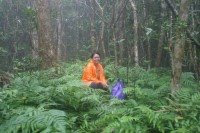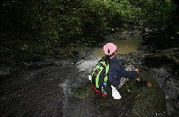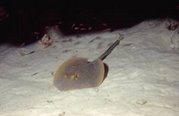
From ME magazine July 2005
Whenever I ask people if they have ever been to Aurora, two out of three give me the classic, “Aurora in Quezon?” Sometimes the confusion no longer surprises, since Aurora used to be part of the province named after the President of the Philippine Commonwealth and husband of Doña Aurora. I, too, was confused until I got to visit the place seven years ago. And I have gone back countless times since then, enough for me to say that I know the province as though it were my own.
Aurora is a land of sweeping beauty, a natural paradise tucked between the mighty Pacific Ocean and the rugged Sierra Madre mountain range. Quite fittingly, its name means “dawn”. Indeed, the province is on the verge of embracing changes that will affect the lives of its residents for many years to come. Former Congresswoman and currently Aurora governor, Bellaflor Angara-Castillo, now steers its development path. She sees the potential of alleviating the poverty of her kababayan (constituents) through sustainable tourism, a decision so timely with the imposition of a total log ban. Governor Castillo believes that a well planned and controlled tourism industry can improve the lives of the poor communities while addressing conservation objectives. The feisty governor believes that a non-extractive industry is a feasible alternative to logging and other destructive activities.
I have reason to agree with her, having toured the province and seen its potential for outdoor recreation, environmental education, and ecotourism. The upcoming book, Treasures of Aurora: People and Environment , is a fitting testimony to the claim that the province offers a cornucopia of adventure. Its mountains, forests, seashores, coral reefs, tidal pools, mangrove areas, hills, coves, rivers, streams and watersheds provide a natural stage for thrills and learning. Being an outdoor buff myself, I can see that the natural environment serves as a huge playground.
The watersheds of Maria Aurora and San Luis, most of which are declared protected areas, are perfect for day hikes, multi-day camping trips or extreme trekking. The numerous waterfalls, some still un-named, never fail to fascinate. The Ditumabo waterfalls, which I attempted but failed to visit in 2000, due to slippery rocks and the absence of a trail, is now accessible through wooden bridges. This simple low impact development was initiated by a group of farmers who simply wanted to share the beauty of their falls with visitors. How they manage this natural wonder is now considered “best practice” among resource mangers.
The marine protected areas of Dinalungan and Dibut Bays also have compelling stories to tell. They are a result of years of concerted effort from the various stakeholders, major and minor players aiming to protect the province’s marine resources in order to ensure food security. Here, they have seasonal sightings of dugongs, dolphins, and whale sharks. Añao Island’s coral reefs, though exposed to the northeastern monsoon at certain times of the year, are amazingly well preserved. Terraces of branching corals adorn the slopes, while fairy basslets make like purple confetti floating on the water and pulsating with the current.
San Ildefonso peninsula, on the other hand, is a seasoned surfer’s haven. This picturesque white sand beach hosts tidal pools created by the pounding waves of the Pacific. What’s left of a beach forest is adorned with 100-year old bonsai trees, their twisting roots and trunks a testimony of resilience against the battering of the Pacific and the howling northeast monsoon. Its pockmarked veined cliffs and caves, constantly and masterfully redesigned by Nature, are considered virgin, never been climbed, rappelled or scaled by man. The forest that caps the peninsula is threatened by increased migration and kaingin (slash and burn) yet it remains an excellent hiking spot. Its streams, waterfalls and caves are a perfect backdrop for adventure enthusiasts and naturalists. Interesting flora and fauna, from common to threatened species, are seen along the trails established by the Dumagat tribe and locals who visit to hunt and gather. On one of my hikes across the peninsula, I saw a stream littered with bluish petals from the endangered purple jade vine.

One doesn’t even have to be in outdoor sports to appreciate Aurora’s natural majesty. Just wake up early enough to catch the sun rising from the Pacific. The rock formation in Digisit is a natural landmark of Baler and a perfect vantage point. I woke up at 4 AM twice to travel 20 minutes to the place. With a mug of hot brewed coffee on hand, I propped my tripod and camera on a ledge, waiting for the sun to peek straight from the horizon and wield strokes of orange, pink and purple, and blue across the sky. The silhouette of Digisit is breathtaking. The transition from shadow to light gives life and texture, not only to the sky, but also to the rock surface, the beach, the forest canopy and the sea’s surface. Here, no two seconds are the same. One learns the value of time and the changes that occur in a brief span.
This magnificent sunrise is symbolic of the hope of the people of Aurora, and the great responsibility in store for visitors who engage with the fragile ecosystems, the people, and the culture of this awesome frontier hidden in the folds of the Sierra Madre.
Aurora is a land of sweeping beauty, a natural paradise tucked between the mighty Pacific Ocean and the rugged Sierra Madre mountain range. Quite fittingly, its name means “dawn”. Indeed, the province is on the verge of embracing changes that will affect the lives of its residents for many years to come. Former Congresswoman and currently Aurora governor, Bellaflor Angara-Castillo, now steers its development path. She sees the potential of alleviating the poverty of her kababayan (constituents) through sustainable tourism, a decision so timely with the imposition of a total log ban. Governor Castillo believes that a well planned and controlled tourism industry can improve the lives of the poor communities while addressing conservation objectives. The feisty governor believes that a non-extractive industry is a feasible alternative to logging and other destructive activities.
I have reason to agree with her, having toured the province and seen its potential for outdoor recreation, environmental education, and ecotourism. The upcoming book, Treasures of Aurora: People and Environment , is a fitting testimony to the claim that the province offers a cornucopia of adventure. Its mountains, forests, seashores, coral reefs, tidal pools, mangrove areas, hills, coves, rivers, streams and watersheds provide a natural stage for thrills and learning. Being an outdoor buff myself, I can see that the natural environment serves as a huge playground.
The watersheds of Maria Aurora and San Luis, most of which are declared protected areas, are perfect for day hikes, multi-day camping trips or extreme trekking. The numerous waterfalls, some still un-named, never fail to fascinate. The Ditumabo waterfalls, which I attempted but failed to visit in 2000, due to slippery rocks and the absence of a trail, is now accessible through wooden bridges. This simple low impact development was initiated by a group of farmers who simply wanted to share the beauty of their falls with visitors. How they manage this natural wonder is now considered “best practice” among resource mangers.
The marine protected areas of Dinalungan and Dibut Bays also have compelling stories to tell. They are a result of years of concerted effort from the various stakeholders, major and minor players aiming to protect the province’s marine resources in order to ensure food security. Here, they have seasonal sightings of dugongs, dolphins, and whale sharks. Añao Island’s coral reefs, though exposed to the northeastern monsoon at certain times of the year, are amazingly well preserved. Terraces of branching corals adorn the slopes, while fairy basslets make like purple confetti floating on the water and pulsating with the current.
San Ildefonso peninsula, on the other hand, is a seasoned surfer’s haven. This picturesque white sand beach hosts tidal pools created by the pounding waves of the Pacific. What’s left of a beach forest is adorned with 100-year old bonsai trees, their twisting roots and trunks a testimony of resilience against the battering of the Pacific and the howling northeast monsoon. Its pockmarked veined cliffs and caves, constantly and masterfully redesigned by Nature, are considered virgin, never been climbed, rappelled or scaled by man. The forest that caps the peninsula is threatened by increased migration and kaingin (slash and burn) yet it remains an excellent hiking spot. Its streams, waterfalls and caves are a perfect backdrop for adventure enthusiasts and naturalists. Interesting flora and fauna, from common to threatened species, are seen along the trails established by the Dumagat tribe and locals who visit to hunt and gather. On one of my hikes across the peninsula, I saw a stream littered with bluish petals from the endangered purple jade vine.

One doesn’t even have to be in outdoor sports to appreciate Aurora’s natural majesty. Just wake up early enough to catch the sun rising from the Pacific. The rock formation in Digisit is a natural landmark of Baler and a perfect vantage point. I woke up at 4 AM twice to travel 20 minutes to the place. With a mug of hot brewed coffee on hand, I propped my tripod and camera on a ledge, waiting for the sun to peek straight from the horizon and wield strokes of orange, pink and purple, and blue across the sky. The silhouette of Digisit is breathtaking. The transition from shadow to light gives life and texture, not only to the sky, but also to the rock surface, the beach, the forest canopy and the sea’s surface. Here, no two seconds are the same. One learns the value of time and the changes that occur in a brief span.
This magnificent sunrise is symbolic of the hope of the people of Aurora, and the great responsibility in store for visitors who engage with the fragile ecosystems, the people, and the culture of this awesome frontier hidden in the folds of the Sierra Madre.







No comments:
Post a Comment